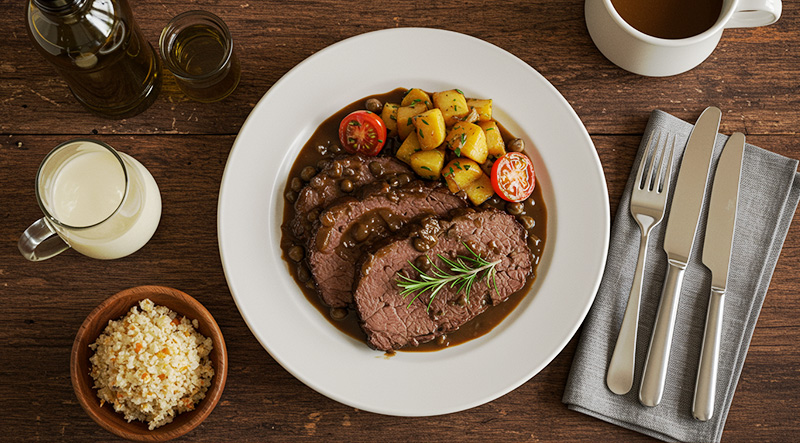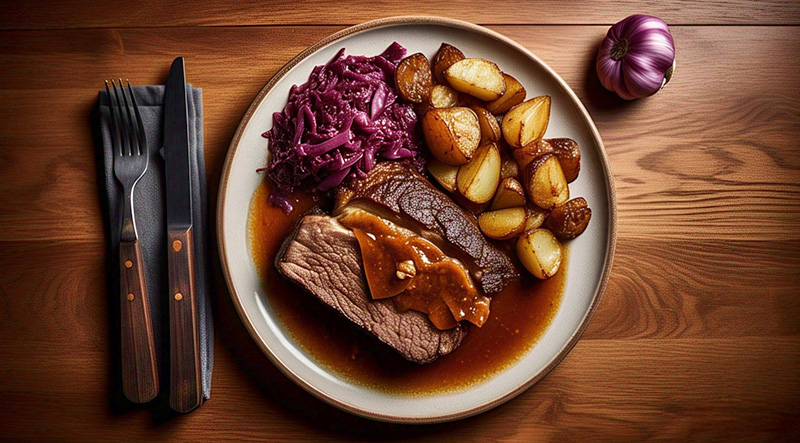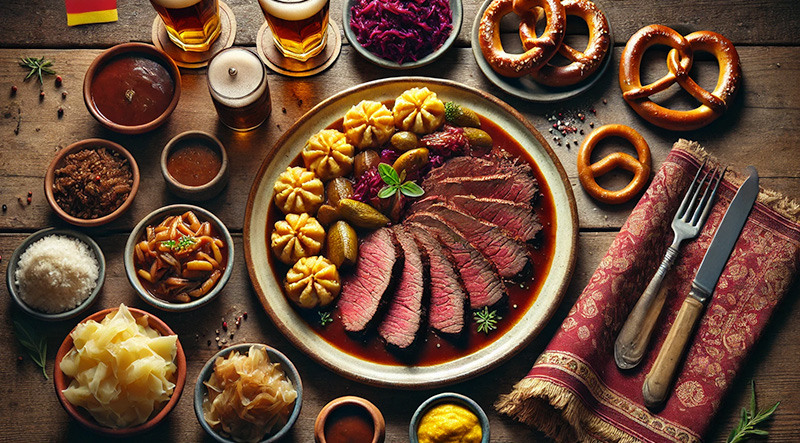Tender, tangy, and steeped in centuries of tradition, **Sauerbraten** is Germany’s beloved national dish and a true celebration of slow-cooked flavor. This rich, marinated pot roast—often made with beef—is soaked for days in a bold blend of vinegar, wine, onions, and spices before being slow-roasted to perfection. The result? A melt-in-your-mouth masterpiece smothered in a sweet-and-sour gravy that’s perfectly paired with hearty sides like red cabbage and potato dumplings. Sauerbraten isn’t just a meal—it’s a comforting taste of German heritage served on a plate. Read More...
The History of Sauerbraten – Germany’s Beloved National Dish:
Sauerbraten, often hailed as Germany’s national dish, is a timeless pot roast that showcases the country’s love for hearty, slow-cooked meals with bold flavors. Known for its signature sweet-and-sour taste, Sauerbraten is more than just a comfort food—it’s a culinary legacy that spans centuries and regions, with a flavor profile as rich as its history.
Origins Rooted in Preservation;
Sauerbraten’s roots trace back to a time before refrigeration, when marination was a practical means of preserving meat. The name comes from two German words: “sauer” meaning sour, and “braten” meaning roast. The dish traditionally begins by marinating beef (though regional versions use pork, lamb, or even horse) for several days in a blend of vinegar, wine, water, onions, and spices such as cloves, bay leaves, peppercorns, and juniper berries. This long marination not only preserved the meat but also tenderized it and infused it with deeply layered flavors.
A Roman and Royal Connection?
One popular legend credits Julius Caesar with influencing Sauerbraten’s creation by introducing the concept of marinating meat in acidic liquids. Another tale gives credit to Charlemagne in the 8th or 9th century. More historically grounded is the association with Johann Wolfgang von Goethe, Germany’s national poet, whose fondness for Sauerbraten reportedly popularized the dish among the upper classes in the 18th century.
Regional Interpretations:
As Sauerbraten spread across the German states, it evolved into distinct regional styles. The Rhenish (Rhineland) Sauerbraten is one of the most famous, often incorporating raisins and gingersnap cookies into the gravy to balance the tartness with a subtle sweetness. Franconian versions may be more acidic, while Saxon styles are typically darker and more robust. In Swabia, Sauerbraten may be served with Spätzle, a soft egg noodle, instead of potato dumplings.
Each region’s variation reflects local ingredients and tastes, but the essential concept of a long-marinated roast with rich, flavorful gravy remains consistent across the country.
A Symbol of German Hospitality:
Sauerbraten isn’t an everyday meal—it’s a special-occasion dish, served at family gatherings, festive Sunday dinners, and holiday feasts. Its labor-intensive preparation is a testament to the care and pride taken in German home cooking. It’s also commonly featured in Gasthäuser (inns) and traditional restaurants, often paired with Rotkohl (braised red cabbage) and Kartoffelklöße (potato dumplings).
The dish’s deep flavor, comforting texture, and visual appeal have helped it endure as a cherished staple for generations.
Global Recognition:
In recent decades, Sauerbraten has gained popularity beyond Germany, especially in communities with German heritage such as Pennsylvania Dutch country in the U.S. There, it’s often adapted with local twists while still honoring the essence of the dish.
It’s also featured on the menus of German cultural festivals, Oktoberfests, and food shows, helping introduce the world to the depth and complexity of traditional German cuisine.
More Than Just a Roast:
Sauerbraten is not just a roast—it’s a story of culture, adaptation, and tradition. It reflects Germany’s history of resourcefulness and culinary craftsmanship, transforming a simple cut of meat into a flavorful masterpiece through time, patience, and a perfected balance of sour and sweet.
Whether served in a Bavarian village or a Berlin restaurant, Sauerbraten remains a taste of German soul, and a proud symbol of its culinary heritage.
Prepare the marinade & Marinate the beef:

Sear the meat:
Sauté the vegetables:

Deglaze and simmer:
Make the gravy:

Slice and serve:
Tips:
Would you like a calorie estimate or preparation time summary next?
The total preparation and cooking time for Sauerbraten is approximately 3 to 5 days, including the essential marination period, plus about 3 hours on the day of cooking. The active prep time takes around 30–40 minutes, which includes making the marinade, searing the meat, and preparing the gravy. The beef must marinate in the fridge for at least 72 hours (though 4–5 days yields deeper flavor). On cooking day, the roast simmers gently for about 2½ to 3 hours, followed by 10–15 minutes to prepare and finish the gravy. While time-intensive, the result is a richly flavored dish worth every minute.
A single serving of Sauerbraten, based on the recipe provided and assuming the roast serves six people, contains approximately 500 to 600 calories. The calorie count comes primarily from the beef roast, which provides protein and fat, as well as the vegetable oil used for searing and the gingersnap-thickened gravy, which adds some carbohydrates and sugar. If you include traditional sides like red cabbage and potato dumplings, the total calorie count per meal can easily reach 700 to 850 calories. Using leaner cuts of beef and reducing the amount of gravy can slightly lower the overall calorie intake.







